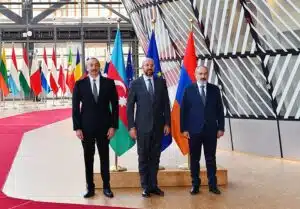A destroyed military vehicle in Nagorno-Karabakh (photo: Flickr)
Amid the Russian invasion of Ukraine, tensions between Armenia and Azerbaijan have increased as reports of ceasefire violations accelerated since begin March. In 2020, both countries fought a 44-day long war in Nagorno-Karabakh, a disputed area between both countries. In this fierce war, Azerbaijan regained much territory that it lost in an earlier conflict in the 1990s – Russia then brokered a ceasefire. While both countries are now in difficult negotiations on mutual recognition of territory, gas supplies to Nagorno-Karabakh are cut off – leaving residents in the bitter cold.
A tense stalemate
For now, Azerbaijan’s President Aliyev refused negotiations inside the OSCE Minks Group framework as he claims the war is “won’’. Outside OSCE’s efforts, EU-mediated Azerbaijani and Armenian negotiations have not produced satisfactory results. Both countries still disagree over the region’s borders and Azerbaijan still holds dozens of POWs, threatening international humanitarian law. Although a hotline between Baku and Yerevan is established, border skirmishes continue – resulting in the death of border guards on both sides. Both countries hold each other responsible for breaking the ceasefire.
Alarmingly, Armenian gas pipelines into Karabakh have been damaged multiple times due to heavy firing. The Karabakh population remains very vulnerable to conflict and is targeted multiple times after the war ended in November 2020. On March 11, citizens reported heavy shelling around the village Khnapat.
Baku’s changing stance towards Russian peacekeeping
Since the invasion of Ukraine, Aliyev’s government has engaged in a defamatory campaign against the presence of Russian peacekeeping forces – who are to remain in Karabakh for four years. Armenia fears that Azerbaijan wants to utilize Russia’s focus on Ukraine to remove peacekeeping forces and gain full control in the area. Tigran Ambrahamyan, an Armenian member of parliament, said on 11 March that “steps happening today aim at discrediting also the Russian role in Artsakh (Armenian for Karabakh) and the South Caucasus in general, which means that the deeper the crisis over Ukraine, the more noticeable these attacks on Russia at different levels will be.”
On Azerbaijani social media, videos of Russian military vehicles traveling along the Lachin corridor – the road between Nagorno-Karabakh and Armenia were shared. It led to rumors that the peacekeepers would leave for Ukraine, providing opportunities for Azerbaijan. On March 10, Nagorno-Karabakh authorities denied that Russians were leaving. While Russian peacekeeping forces provided frequent online updates on its activities in the region, it is now silent since January 26. These developments seem troublesome as skirmishes between Azerbaijani and Armenian forces increase.
Moreover, the developing rhetorical campaign against Armenia in Azerbaijan is highly concerning. After decades of conflict, the population of Nagorno-Karabakh remains vulnerable to ethnic violence and needs protection from the international community from conflict. In today’s fast-changing geopolitical environment, large-scale violence in Nagorno-Karabakh can flare up very quickly – and western actors must prevent a new round of conflict in the Southern Caucasus from happening.
Sources: Open Democracy Radio Free Europe I Eurasianet I Eurasianet II Radio Free Europe II



